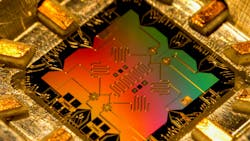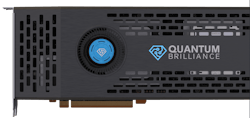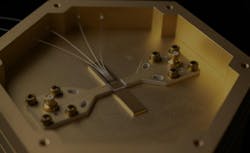Will Diamonds Revolutionize Quantum Computing?
What you’ll learn:
- What do diamonds have to do with quantum computing?
- What is the state of practical quantum computing?
- Do quantum-computed engines fit into a PC?
Quantum computing, a technology that’s been in the lab, promises significant performance increases for certain types of problems such as attacking existing encryption technologies. Superconducting systems were employed in early quantum computers. Different approaches to creating quantum computers have been developed, including silicon-based approaches. One of the latest technologies is based on diamonds.
Diamond Qubits for Room-Temperature Quantum Acceleration
NVIDIA is partnering with Quantum Brilliance to deliver room-temperature quantum accelerators. The first 19-in. rack-mount system went to Fraunhofer IAF.
The QB-QDK2.0 is actually a hybrid quantum-classical compute node that includes CPUs and NVIDIA GPUs in addition to the quantum processor unit (QPU) from Quantum Brilliance (Fig. 1). The hardware lets developers try out different software configurations.
“Quantum Brilliance’s work with Fraunhofer IAF points to a future where quantum hardware is collocated with AI supercomputers, unlocking new possibilities for hybrid quantum-classical computing” said Tim Costa, Senior Director of CAE, EDA & Quantum at NVIDIA. “NVIDIA’s CUDA-Q platform is supporting researchers in developing and scaling these hybrid systems, which lead the charge to useful quantum computing.”
The Qristal accelerators in this second-generation Quantum Development Kit (QB-QDK2.0) use nitrogen-vacancy centers in diamonds where spin-dependent photoluminescence allows for optical measurement. This process works at room temperature.
Quantum Brilliance software includes the open-source, Qristal SDK and Qristal Emulator. The latter simulates a quantum-computing back-end with realistic noise models. This runs on NVIDIA’s CUDA-Q platform.
CUDA-Q is a quantum-processing-unit (QPU) agnostic system that can be used for quantum-computing development, enabling the creation of high-performance-computing (HPC) applications that take advantage of a QPU.
Quantum Interconnect Bandwidth Needed for Quantum Computers
Lightsynq is developing integrated diamond photonic interconnects. The company hasn’t released a lot of details about its technology, but it targets communication and storage to complement quantum computers. Early research demonstrated memory-enhanced quantum communication capabilities. The memory-enhanced quantum technology is based on “color centers in diamond photonic circuits.”
>>Check out this TechXchange for similar articles and videos
Lightsynq’s quantum-memory technology embeds silicon atoms into diamond to form a two-qubit register, silicon-vacancy color centers (SiVs) that can be controllable using microwave pulses (Fig. 2). SiVs provide fast qubit initialization and access using optical transitions to achieve “high-fidelity, high-efficiency interactions between single photons and the SiV's electron qubit.” All of this is packed into a photonic integrated circuit (PIC). Multiple PICs are combined into parallel memory registers in a single chip.
"Diamond holds immense potential for quantum computing. It’s important for Lightsynq to have a trusted strategic partner such as Element Six on board to put this technology to the test," said Dr. Mihir Bhaskar, CEO and Co-Founder of Lightsynq.
He added, "Linking quantum computers is challenging because it requires entanglement to be shared across multiple systems. Additionally, entanglement is sensitive to noise and can be difficult or slow to transmit using conventional interconnect approaches. Element Six’s synthetic diamond technology helps overcome these challenges, enhancing our ability to connect quantum computers and accelerate the timeline to useful quantum solutions."
Quantum Computers and the Cloud
Quantum-computer support is likely to be in the cloud for most developers initially. The hardware from Quantum Brilliance could change that depending on the cost and capability of the accelerators, which is an unknown at this point.
IBM recently announced its Heron chip that’s capable of running applications employing circuits with 5,000 two-qubit gates. It’s supported by the Qiskit platform. The Qiskit Functions Catalog lets developers create and release Qiskit Functions for general use.
“Advances across our hardware and Qiskit are enabling our users to build new algorithms in which advanced quantum and classical supercomputing resources can be knit together to combine their respective strengths," said Jay Gambetta, Vice President, IBM Quantum. "As we advance on our roadmap towards error-corrected quantum systems, the algorithms discovered today across industries will be key to realizing the potential to solve new problems realized through the convergence of QPUs, CPUs, and GPUs.”
QPUs are still in the experimental and growing stage but that could change quickly. The ability to run at room temperature radically changes the size and scope of the hardware.
Software development for quantum computers is also in a state of flux similar to what happened with artificial intelligence and machine learning (AI/ML) at its inception. At that point, just a few models and frameworks were available. Now they’re almost too numerous to count, with new approaches like generative AI taking the world by storm.
We’re just learning about and addressing many of the issues related to quantum computing from error correction to data transfer. Just as AI/ML has pushed communication technology, quantum computing is likely to take it to the next level. Similarly, the combination of AI/ML and quantum computing will probably lead to new and interesting problems and solutions.
>>Check out this TechXchange for similar articles and videos
About the Author
William G. Wong
Senior Content Director - Electronic Design and Microwaves & RF
I am Editor of Electronic Design focusing on embedded, software, and systems. As Senior Content Director, I also manage Microwaves & RF and I work with a great team of editors to provide engineers, programmers, developers and technical managers with interesting and useful articles and videos on a regular basis. Check out our free newsletters to see the latest content.
You can send press releases for new products for possible coverage on the website. I am also interested in receiving contributed articles for publishing on our website. Use our template and send to me along with a signed release form.
Check out my blog, AltEmbedded on Electronic Design, as well as his latest articles on this site that are listed below.
You can visit my social media via these links:
- AltEmbedded on Electronic Design
- Bill Wong on Facebook
- @AltEmbedded on Twitter
- Bill Wong on LinkedIn
I earned a Bachelor of Electrical Engineering at the Georgia Institute of Technology and a Masters in Computer Science from Rutgers University. I still do a bit of programming using everything from C and C++ to Rust and Ada/SPARK. I do a bit of PHP programming for Drupal websites. I have posted a few Drupal modules.
I still get a hand on software and electronic hardware. Some of this can be found on our Kit Close-Up video series. You can also see me on many of our TechXchange Talk videos. I am interested in a range of projects from robotics to artificial intelligence.




